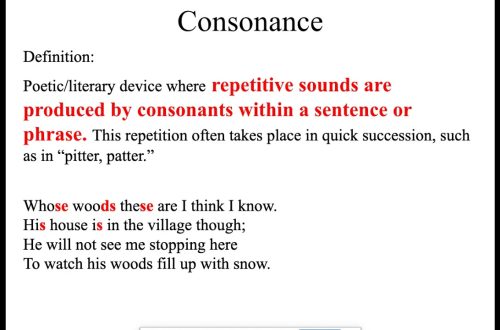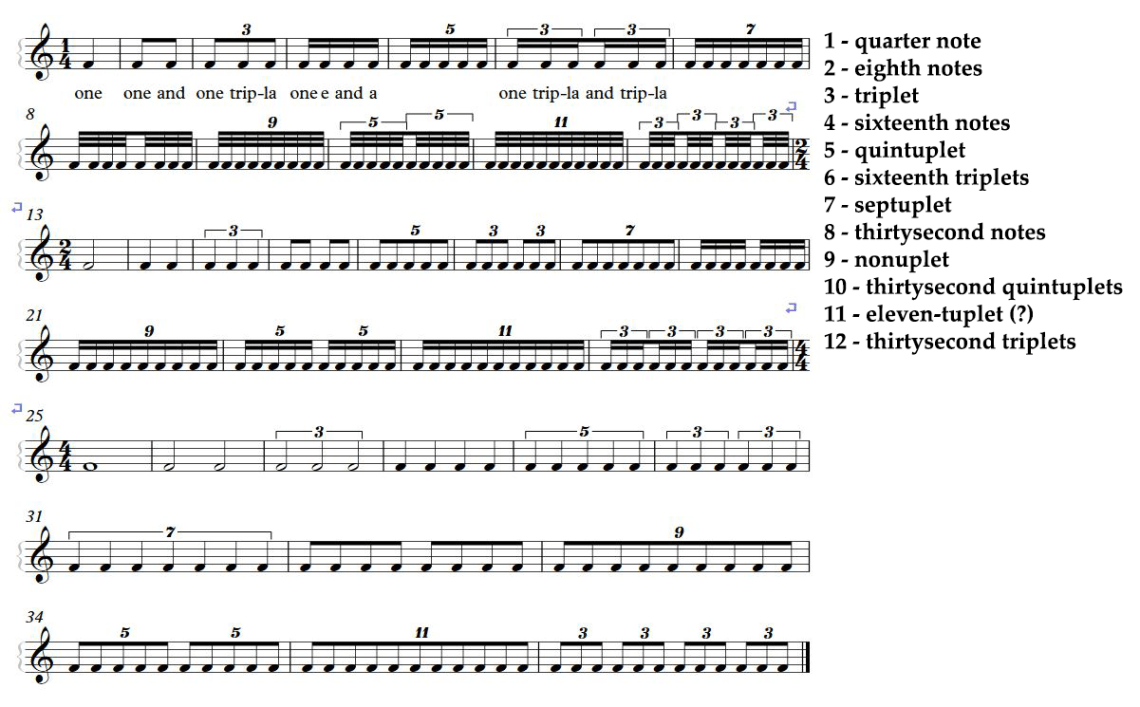
Triplets, quintuplets, and other unusual note values
Contents
Somehow we have already said that with the help of the main durations, the composer does not always succeed in recording the rhythm he wants. Therefore, there are various rhythmic anomalies (let’s call it that) and ways of rhythm deformation. And today we invite you to get acquainted with new, unusual durations – triplets, quartoles, quintoles, etc. But first things first.
Types of rhythmic division
In music, there are two principles of rhythmic division of note durations and pauses: even (basic) and odd (arbitrary). Let’s take a closer look.
EVEN (or BASIC) DIVISION – this is such a principle according to which the next smaller note in duration is formed by dividing a whole note by the number 2 in some mathematical power (that is, into 2, 4, 8, 16, 32, 64, 128, 256, 512 or 1024 parts ).
You know the duration of even-numbered notes well. These are half, quarter, eighth notes that have long become familiar to you, or those that are smaller than them – sixteenth, thirty-second, etc.
ODD (or ARBITRARY) DIVISION – this is the principle according to which a whole or some other note can be divided into any number of parts: into three, five, nine or sixteen, nineteen or twenty-two, etc.

“Divide a note into 22 parts? Hm! It sounds somehow implausible, ”you might think. However, we will assure you that there are a huge number of examples of such a division in music. For example, the famous Polish composer Fryderyk Chopin was very fond of introducing such “things” into his piano pieces. Here we will open his first nocturne (see a fragment of the musical notation below). And what do we see? On the first line there is a group of 11 notes, on the second – of 22. And a lot of such examples can be found not only in Chopin, but also in many other composers.
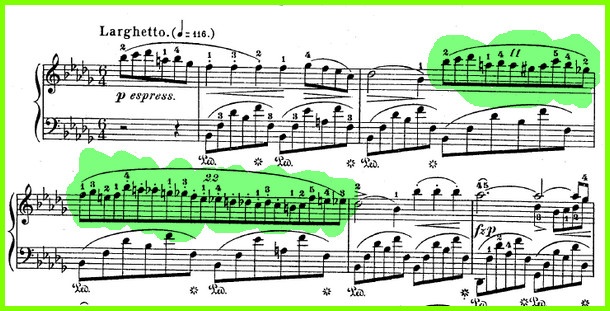
Rhythmic figures of odd division
Of course, the “musical constitution” allows you to divide a note into nineteen parts, and into twenty-eight, and thirty-five, but still there are “traditions” as well. There are such “wrong” rhythmic figures, which among all the others are most common, certain names have been assigned to them, and we will analyze them right now. So, everything is in order.
TRIOLS – they are formed by dividing some duration not into two parts, but into three. For example, a quarter note can be divided not into two eighths, but into three, and they, of course, will be faster compared to even eights. Similarly, a half note can be divided into three quarter notes instead of two, and a whole note into three half notes.
Eighth triplets, as a rule, are collected in three pieces in one group under one edge (“roof”). The number three is placed above or below, which indicates a similar method of division. The sixteenth notes of the triplets are also drawn up. And larger durations, that is, quarters and halves, which are never connected by edges, are also grouped in threes, only with the help of a square bracket. And the number three in this case is also a mandatory attribute.
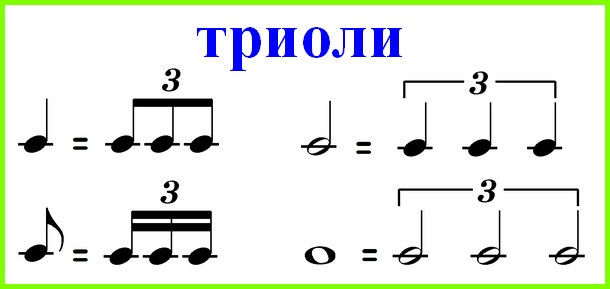
QUINTOLI – these durations occur when a note is divided into five parts instead of four. For example, a quarter can be split into four sixteenth notes, but it turns out that it can also be divided into five. Like – with a half: it can be divided into four eighths, or into five eighth quintoles. And the whole duration can be divided, respectively, into five quarters instead of four.

IMPORTANT! The principle of registration of all notes of odd division is universal. Notes that are connected into a group using edges are simply marked with the desired number above or below (quintoles – the number five).
If the notes are recorded separately each (quarters, half or the same eighths, but with tails), then the group must be shown with a square bracket and a number.
Triplets and quintuplets of odd lengths are probably used most often. Do you understand the principle of odd division? Excellent! Let’s list a few more cases that musicians encounter a little less often.
SEXTOL – dividing a note into six parts instead of four. In fact, a sextol can be formed by adding two triplets. For example, dividing a quarter into six sixteenths instead of four.
SEPTOL – division of a note into seven parts instead of eight or instead of four. In the first case, these will be slightly slowed down durations, and in the second, on the contrary, they will be accelerated.
НОВЕМОЛЬ – dividing a note into nine parts instead of eight. Example: splitting a half-length into nine sixteenth notes instead of eight.
DECIMOL – dividing the duration into ten parts instead of eight. Let’s say that eight eighths generally fit in a whole note, but you can also fit ten, then they will be a little more hasty than usual.
Dividing a note with a dot into two and four parts
Interesting cases of “incorrect” division of durations arise when dividing notes with a dot, which are most conveniently divided into three equal durations, into two or four parts. In other words: what should easily be divided into three parts is divided into two or four, also causing rhythmic anomalies. Such cases include:
DOUBLE – they are obtained when a note with a dot is divided into two parts. For example, a quarter with a dot is easily divided into three eighths, but those who are not looking for easy ways divide it into two.
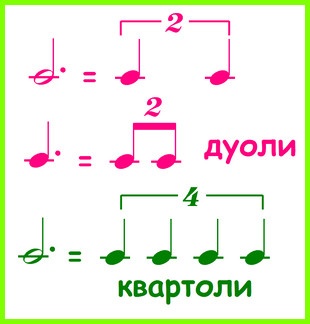
Duols, of course, sound more drawn out, heavier than normal eighth notes. Judge for yourself: a quarter with a dot, relatively speaking, lasts one and a half seconds. If you don’t understand now why I mentioned seconds here at all, then please read the material “Signs that increase the duration of notes”. We talked about it there.
So, a quarter with a dot is one and a half seconds, the usual eighth is half a second, and it is more logical to divide this unfortunate quarter into three eighths, but we divide by two. And we get that every eighth is enlarged, it lasts three quarters of a second (1,5/2 = 0,75 s).
Similarly, a half with a dot can be divided not into three normal quarters, but into two larger ones. That is, our half with a dot is 3 seconds, the usual quarters are 1 second each, but we got one and a half (3/2 u1,5d XNUMX s).
QUARTOLIS – these even durations with an insanely difficult to perceive movement come across to us when a note with a dot is again divided not into three parts, but into four. For example, a dotted quarter note is divided into four eighth notes instead of three, or a dotted half note is divided into four quarter notes. Quartoli are played faster, easier than regular eighths and quarters.
Rhythmic Exercises with Triplets and Quintoles
Everything related to music must be learned not only with the mind, but also with the ear, that is, musically. That is why we try to offer you not only dry theoretical material, but also at least very simple exercises so that you can not only learn about triplets, but also listen to how it sounds.
EXERCISE No. 1 «TRIOLI». Eight-note triplets are most often found in music. In the proposed exercise there will be different durations, we will swing gradually. In the first measure there will be even quarters – uniform beats of the pulse, then ordinary, even eighths will go on, and in the third measure – triplets. You will recognize them by their characteristic grouping and by the number three in the musical example. Listen to the audio recording of the example and try to catch the difference between these rhythms.

Practice rhythms of different durations separately. You probably heard different types of movement by ear. Did you hear how clearly the triplets pulsate? They clearly feel a beating like “one-two-three, one-two-three”, etc., the first note of the triplet is a little more active, stronger than the next two. Try to tap this rhythm, you need to remember the sensations.
Another similar exercise with a different melodic pattern.

EXERCISE №2 “LISTENING TO BEETHOVEN”. One of the most famous pieces of classical music in the world is Beethoven’s Moonlight Sonata. It turns out that its first part is thoroughly permeated with the movement of triplets. We invite you to listen to a piece of the beginning of the first part and follow the rhythm of the fragment by notes.
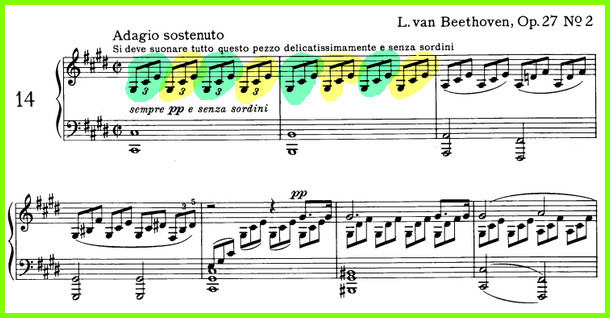
It is the calm swaying of triplets in Beethoven’s music that both hypnotizes and creates a mood conducive to reflection.
EXERCISE №3 “LISTENING TO THE TARANTELLA”. But triplets can sound completely different than in the previous example. For example, there is such an Italian folk dance – tarantella. By nature, he is very mobile, slightly nervous and very incendiary. And to create such a character, a quick movement in triplets is often introduced.
As an example, we will show you the famous “Tarantella” by Franz Liszt from the cycle “Years of Wanderings”. Its main theme is built on a clear triplet movement. It will be very fast, stay tuned!
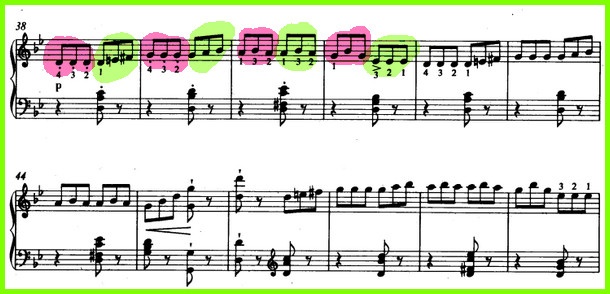
EXERCISE #4 «QUINTOLI». It can be difficult to put five small durations into one unit of time, into one share at once. It’s difficult, but it needs to be learned. In the example below, there will be sixteenth-quintoles, which are obtained by dividing a quarter note into five parts. First, even quarters are given, and then rhythmic sequences with fifths.

By the way, in the musical text of this example, you met the signs of sharp, flat and bekar. Have you forgotten what it is? If you forgot, you can repeat HERE.
EXERCISE №5 “Subtext”. We know that it is difficult to master the rhythm of quintoles right away. Someone fails to have time to play five notes in the allotted time, for someone the quintuplets turn out to be crooked – unequal in duration. To correct the situation, we offer you an exercise with subtext.
What is subtext? This is when words and expressions with the same rhythm are selected to the music. And then the rhythm of the words, which must be sung or spoken aloud, helps to master the rhythm of the musical.
Let’s take the same rhythmic figures of quintoles as in the task above, and choose suitable words for them. Here you can think of anything, the main thing is that the word or phrase has only five syllables, and the first syllable is stressed. For example, such expressions are suitable for us: the sky is blue, the sun is bright, the sea is warm, the summer is hot.
Shall we try? Let’s take it a little slower. Each note has one syllable.

Worked out? Great! This is where we will stop for now. In the next releases, you will continue the conversation about the different sides of the musical rhythm. If you have any questions about the topic of this article, write them in the comments.
Dear friends, in the end, we invite you to listen to some good music: the piano Tarantella by Sergei Prokofiev from the Children’s Music cycle. Try to catch the incendiary rhythms of triplets in it too.




